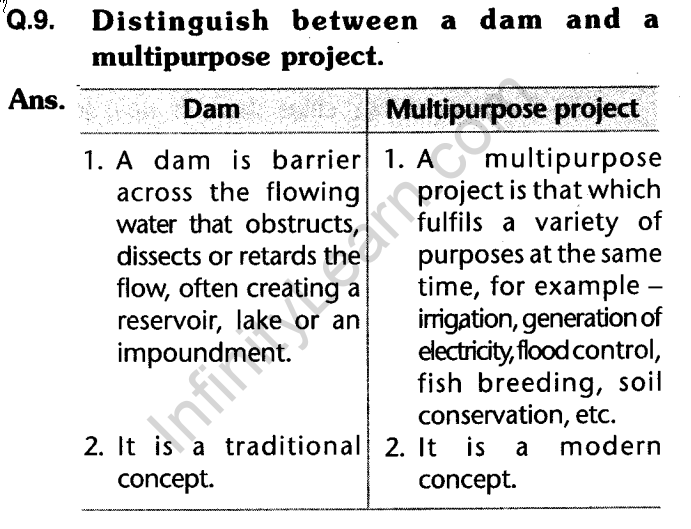Table of Contents
CBSE Class 10 Geography Important Questions – Chapter 3 Water Resources
Q.1. What is hydrological cycle? What is its importance ?
Ans. The cycle of water moving around the planet, known as the hydrological cycle, involves water continuously traveling in different ways—like rain, rivers, and underground. Our main sources of fresh water come from rain that flows over the land and from groundwater that gets refilled in this ongoing cycle. Essentially, it’s all about water constantly circulating through this cycle.
Q.2. How has agriculture aggravated the problem of water scarcity in India ? Explain.
Ans.
(i) Water is a basic input in agriculture. It is used for irrigation.
(ii) HYV seeds needs more water as compared to traditional seeds.
(iii) Commercialization of agriculture has also lead to withdrawal of groundwater at a large scale.
(iv) Overuse of groundwater is another problem associated with agriculture. The water table has lowered in many parts of India due to its overuse.
Also Check: CBSE Syllabus Class 1 to 12
Q.3. “Water scarcity may be an outcome of large and growing population”. Justify.
Ans.
(i) A large population means more water not only for domestic use but also to produce more food.
(ii) Most of the Indian cities are facing the problem of water due to growing population. .
(iii) A growing population has also a direct impact on the water level.

Q.4. How does urbanisation and urban lifestyle lead to over-exploitation of water resources ? Explain.
Ans.
(i) Most of our cities are over populated. Overpopulation leads to our utilization of water resources
(ii) Urbanization especially unplanned urbanization adds to water pollution.
(iii) Urbanization also damages the existing water resources especially the river. For example, most of Indian river have been polluted by the waste of cities.
Q.5.Is it possible that an area or region may have ample water resources but is still facing water scarcity ? Explain with the help of three relevant examples.
Ans. Yes it is possible that an area or region may have ample water resources but is still facing water scarcity. Most of our cities are facing this proble.
(i) In most of our cities there is no shortage of water but the water is unfit for consumption.
(ii) Most of our cities are in the banks of rivers, but rivers have been turned into toxic streams.
(iii) The ever increasing population, industries and vehicles has made matter worse by exerting pressure on existing freshwater resources.
Also Check: CBSE Board Exam Date Sheet 2024
Q.6. What is importance of water?
Or
“Water is a very important and critical resource in India.” Support the statement by explaining any three points.
Ans.
(i) Water is vital for human survival.
(ii) Water is used for transportation.
(iii) In industries water is used as a coolant.
(iv) Water is also used for power production.
(v) Water is a basic input for agriculture.
Q.7. How do increasing number of industries exert pressure on existing freshwater resources?
Ans.
(i) industries used water as coolant, raw material, solvent, etc.
(ii) Industries release harmful chemicals which contaminates water.
(iii) Most of the Indian rivers are polluted due to toxic chemicals which are released by industries.
Q.8. What are dams? How do these help to conserve and manage water ?
Ans. A dam is a barrier across flowing water that obstructs, directs or retards the flow often creating a reservoir, lake or impoundment.
(i) Dams were traditionally built to impound rivers and rainwater that could be used later to irrigate agricultural fields.
(ii) Dams are also source of perennial canals.
Also Check: CBSE Board Exam Date Sheet 2024
Q.9.Distinguish between a dam and a multipurpose project.

Q.10.Who proclaimed the dams as the temples of modern India ? Give reason.
Ans. Jawaharlal Nehru proudly proclaimed the dams as the ‘temples of modem India’; the reason being that it would integrate development of agriculture and the village economy with rapid industrialisation and growth of the urban economy.
Q.11.‘Multipurpose projects and large dams have also been the cause of many social movement’. Name any two such movements. Why these movements were launched ?
Ans. Multipurpose projects and large dams have also been the cause of many new social movements like the ‘Narmada Bachao Andolan’ and ‘Tehri Dam Andolan’ etc. Resistance to these projects has primarily been due to the large – scale displacement of local communities. Local people often had to give up their land, livelihood and their meagre access and control over resources for the greater good of the nation.
Q.12. How do the dams create conflicts between the people ?
Ans.
(i) The dams have created conflicts between people wanting different uses and benefits from the same water resources.
(ii) Inter-state water disputes are becoming common with regard to sharing the costs and benefits of the Projects.
(iii) The landowners, the rich farmers, industrialists and urban centres are benefitting at the cost of local communities.
In Gujarat, the Sabarmati – basin farmers were agitated and almost caused a riot over the higher priority given to water supply in urban areas, particularly during droughts. Inter – state water disputes are also becoming common with regard to sharing the costs and benefits of the multipurpose project.
Q.13. How has irrigation changed the cropping pattern? What is its impact on the social landscape?
Ans. Due to irrigation facilities many farmers have shifted to water intensive and commercial crops. For example, Punjab has become major producer of rice inspite of low rainfall.
Impact on social landscape:- This transformation has widens the gap between rich and poor. The rich and mighty who can afford higher inputs has become more rich whereas the poor have failed to get benefit due to lack of capital.
Q.14. Explain three ways in which irrigation schemes have changed the social landscape of the region.
Ans.
(i) Displacement of the local people : Local people often had to give up their land, livelihood and their meagre access and control over resources for the greater good of the nation.
(ii) Social movements : Multipurpose projects and large dams have also been the cause of many new social movements like the ‘Narmada Bachao Andolan’ and the ‘Tehri Dam Andolan’, etc.
(iii) Widening the gap between rich and poor : Multipurpose projects have widened the gap between rich and poor. The landlords, large farmers and industrialist are getting benefit at the cost of poor.
Q.15. “Multipurpose projects have failed to achieve the purpose for which they were built”. Justify by giving reasons.
Ans.
(i) These dams were constructed to control floods but they have triggered floods due to sedimentation in the reservoir.
(ii) Moreover, the big dams have mostly been unsuccessful in controlling floods at the time of excessive rainfall.
(iii) Many a time authorities are forced to release water from dams during heavy rainfall.
Q.16. What is rainwater harvesting ? What is its importance ?
Ans. It is a technique of increasing the recharge of ground water by capturing and storing rainwater by constructing structures such as percolating pits, check dams, etc.
Importance:-
(i) Rainwater harvesting is the need of hour as demand for water is increasing day by day.
(ii) Rainwater harvesting reduces pressure on existing water resources.
(iii) It is cheap source of water supply.
(iv) It helps in recharging groundwater.
(v) The rainwater store is extremely reliable source of drinking water when all other sources are dried up.
Q.17. (i) What is a multipurpose project?
(ii) Why did Pandit Jawahar Lai Nehru proclaim the river dams as the ‘Temples of Modem India?’ Explain the main reason.
Ans.
(i) A multipurpose project is that which fulfils a variety of purposes at the same time, for example – irrigation, generation of electricity, flood control, fish breeding, soil conservation, etc.
(ii) It would integrate development of agriculture and the village economy with rapid industrialisation and the growth of urban economy.

Q-18. Explain the rooftop rainwater harvesting technique.
Ans.
(i) Rooftop rainwater is collected using a PVC pipe.
(ii) Collected water is filtered using sand and bricks.
(iii) Underground pipe is used to take the water to the sump for immediate usage.
(iv) Excess water from the sump is taken to the well.
(v) Water from the well recharges the underground water.
Q.19. Why are different water harvesting systems considered a viable alternative both socio economically and environmentally in a country like India?
Ans.
(i) Water harvesting is a very cheap and affordable method of conservation of water.
(ii) Indian people have in-depth knowledge of rainfall regime and soil type. They have developed techniques to harvest rainwater, groundwater, rain water and flood water in keeping with the local ecological conditions and their water needs.
(iii) Rainwater harvesting techniques are more environmental friendly as compare to multipurpose river projects.
Water Resources SAQ Geography CBSE Class 10 FAQs
What are water resources for Class 10 CBSE?
Three fourth of the earth is covered with water, but only 2.5 per cent out of the total water volume exists as freshwater. The rest 96.5 per cent is salt water from the ocean. More than 70 per cent of the freshwater source exists as glaciers in Antarctica and high altitude mountain regions of the world.
What is the water resources PDF?
Water resources are sources of water that are useful or potentially useful to humans. Uses of water include agricultural, industrial, household, recreational and environmental activities. Virtually all of these human uses require fresh water.
What is chapter 3 of geography class 10?
CBSE Notes Class 10 Geography Chapter 3 - Water Resources.
What is water resources in points?
Water resources refers to natural resources of water that are potentially useful as a source of water supply. About 97% of the water on the Earth is mainly salt water and only around 3% is fresh water; approximately around two thirds of this is frozen in glaciers and polar ice caps.
What are the short notes on water resources?
Water resources are natural resources of water that are potentially useful for humans, for example as a source of drinking water supply or irrigation water. 97% of the water on Earth is salt water and only three percent is fresh water; slightly over two-thirds of this is frozen in glaciers and polar ice caps.





